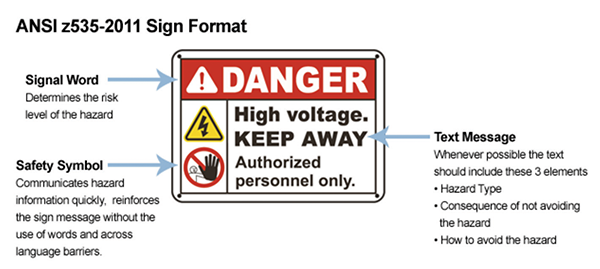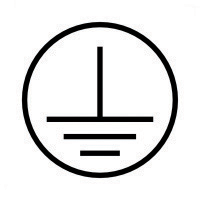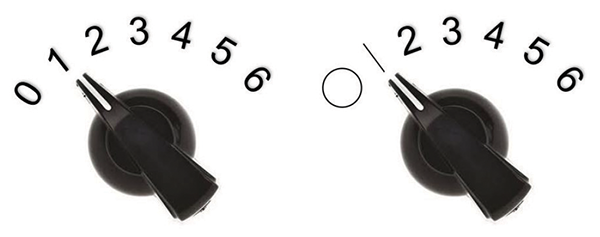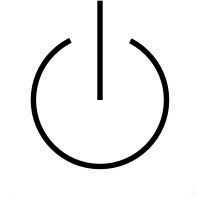The paper on which this article is based was originally presented at the 2019 IEEE International Symposium on Product Safety Engineering in San Jose, CA. It is reprinted here with the gracious permission of the IEEE. Copyright 2019 IEEE.
Markings and labelling on a product provide a multitude of information for safe installation and safe use of the product. The markings can also provide warnings to avoid hazardous energy transfer to a body part. This paper addresses the safety-related markings and labels and explains the safety reasons for these markings.
In general, product markings should be located near or adjacent to the part or region that is the subject of the marking. Unless they apply to that part, markings shall not be put on parts that can be removed without the use of a tool.
Marking Legibility and Permanency
Product markings related to the safety of the product must be legible and permanent (for the life of the product). Non-safety-related markings are not subject to the legibility and permanency requirements.
The marking and labeling requirements are primarily governed by end-product standards. However, there are standards that are expressly for markings and labels [1], [2], [3].
Most standards specify tests to determine if the marking is legible and permanent.
Before testing, the marking or label is subjected to conditioning such as water immersion, high and low temperatures, chemical immersions, ultraviolet weathering, etc., that simulate the conditions that would be encountered in the intended use. After the environmental conditioning, the marking or label is visually examined for deterioration.
Often, the test for permanency uses a mild solvent such as water, hexane, denatured ethyl alcohol, isopropyl alcohol, or other liquids, and then rubbing with a Q-tip, cloth, or equivalent, soaked with one or more of the liquids. Rubbing has controlled pressure and time. The rubbing tests are on an actual or representative end-product surface. After the tests, the marking or label is again visually examined for deterioration. The acceptable degree of deterioration is subjective.
If an adhesive label, a peel strength test is also performed. The standards often specify the test details and the acceptable peel strength force.
Identification of the Product
In case of a safety problem with the product, the product manufacturer or vendor and model number must be identified so that the product owner or user may contact the manufacturer or vendor to remedy the safety problem. See Table 1.
| Identification | Manufacturer, model, etc. |
| Ratings | Voltage, current, power, etc. |
| Functions | Controls, especially power on- off |
| Connections | Power, other |
| Warnings | Required behavior of the user to prevent injury |
Table 1: Product Markings
Manufacturer Identification
The manufacturer or vendor is identified by means of a marking on the equipment. Identification may be the manufacturer’s or vendor’s name, trademark, or other equivalent identification.
Model Identification
Associated with the manufacturer or vendor is the model number, model name, or equivalent also marked on the product.
Individual Unit Identification
To limit the extent of remedy actions, the manufacturer or vendor may choose to include a serial number, date code, batch code, etc., marking. If the remedial action does not apply to all units, identification of individual units or a batch of units allows the manufacturer to limit his remedial action only to affected units. This is usually not a requirement.
Owner registration
Some manufacturers ask the owner to register his product with the manufacturer so that the manufacturer can contact the owner directly in case of a safety problem. (This process also allows the manufacturer to provide updates and sales pitches for add-on and additional products.) When registration was done by mail (via what was known as a bingo card), many owners chose not to register their product.
Today, most product safety problems are identified by public announcement. In the USA, consumer product safety problems are announced on the Consumer Product Safety Commission web site [4].
Product Ratings
The product must be connected to an energy source in order to operate. Connecting the product to an incorrect energy source may damage some product safeguards or installation safeguards. For this reason, energy source ratings must be marked on the product.
The energy source may be an internal source, e.g., replaceable battery, or an external source, e.g., USB, or power over Ethernet, or solar power, or low-voltage dc, or ac mains, etc. Regardless of the source, the energy source (or sources) must be identified by a marking on the product.
Battery Rating
Batteries are either industry-standard or custom. If industry- standard, such as AA, then the rating marking need only be the size, e.g., AA or LR6. If the battery is custom, then the rating marking may be the replacement identification such as a part number. In some cases, the battery mechanical configuration is unique and controls a suitable replacement
The voltage of an industry-standard battery depends on its chemical composition. The voltage of a zinc-carbon or alkaline battery is nominally 1.5 volts per cell. The voltage of a rechargeable battery such as nickel-cadmium or nickel-metal- hydride is nominally 1.2 volts per cell. While these batteries may be the same physical size, 1.2 volts may be low enough to prevent a product rated for a 1.5-volt battery from working. And, a 1.5-volt battery is likely to be severely overloaded if replacing a 1.2-volt battery, and is likely to overheat when subjected to charging.
All batteries wear out. The product should be marked to identify the replacement battery and, if rechargeable, its chemistry.
Voltage Rating
Most non-battery-operated products operate from an external voltage source. If the voltage source is higher or lower than the product operating voltage, the product could overheat and damage the product safeguards. So, the product operating voltage must be marked on the product so that the connection is to a voltage source within the product operating voltage range.
All products operate over a range of power input voltage, whether the voltage is from a battery, low-voltage dc source, ac- mains source, etc. The product voltage marking can be a nominal voltage or a range of voltages. The product standard specifies the acceptable voltage marking details.
Most low-voltage-operated products use a nominal voltage marking, especially dc-operated products. Today, most ac- mains-operated products use switching-mode power supplies so are wide-ranging, e.g., from 100 volts to 240 volts, and are so marked.
“NATURE” or “CHARACTERISTIC” of the Supply
IEC 62368-1: “The nature of the supply voltage, DC, AC, or three-phase AC, shall be marked on the equipment and shall immediately follow the equipment voltage rating.”
250 V AC
IEC 61293: “If a given sequential order is needed, or the space available is restricted, for example, to one line, the following sequence is recommended:
characteristics of the supply system;
rated values and unit symbols;
other characteristics.”
AC 250 V
There is no safety consequence whether the “AC” precedes or follows the voltage rating. The only criterion should be, as previously mentioned, that the “AC” marking be near or adjacent to the voltage rating marking. Apparently, these two committees feel that the placement of the “AC” does affect the safety of the product.
Current Rating and Power Rating
Products draw current from the voltage source. The voltage source must be able to supply this current. All voltage sources are limited to a maximum current; a product that exceeds this current can cause the voltage source to drop, or shut off, or overheat. To determine (before installation) the compatibility between the product and the voltage source, the product maximum current (or power) is marked on the product.
In some jurisdictions, and for some installations, the product current cannot exceed 80% of the voltage source current rating.
Some standards require the power rating rather than the current rating. Some standards allow either current or power rating. (The power rating may be used to determine heating or cooling for the installation.)
Frequency Rating
Many products are sensitive to frequency. If the product employs a mains-frequency transformer, a low frequency will cause the transformer to overheat. If the product employs a switching-mode power supply, the product is probably relatively insensitive to frequency, although at low frequencies and heavy load the product may not work.
Fuse Rating
A fuse is a safeguard, usually against electrically-caused fire, but sometimes against electrically-caused injury. To prevent fire or electrically-caused injury, it is imperative that the fuse be replaced by one with the same set of ratings.
If a replaceable fuse is used in the product, whether user- replaceable or serviceman-replaceable, information as to an equivalent replacement fuse is required to be marked near the fuse. Usually, the marking would include at least voltage and current ratings. In some cases, the fuse interrupt-current rating may be appropriate.
Power Output Rating
If the product has a power output, the voltage, whether dc or ac, if ac, the frequency, and the maximum available current must be marked on the (host) product. This enables the user to ensure power compatibility between the power output of the host product and the power input of the auxiliary product. Connecting an auxiliary product to an incorrect power source may damage the auxiliary product safeguards or the host product safeguards.
Laser Class Rating
Laser radiation of sufficient magnitude can cause injury to the eye or skin. Regardless of magnitude, if the product employs a laser, then the laser class must be marked on the product. Thus, the user is informed that the product employs a laser and the range of magnitude of laser energy.
Temperature Limiter Rating
Some products use temperature limiters to prevent overheating and thermally-caused injury or safeguard damage. If the temperature limiter is replaceable, the ratings must be marked so that an acceptable replacement can be used.
Product Control Functions
Power Disconnect (On-Off) Control
All products must have a means for disconnecting the power from the product in case of a safety-related problem (as well as servicing the product).
Disconnection is by means of a switch marked “OFF” and “ON” or the “0” and “1” symbol (IEC 60417, Symbols 5007, 5008, 5010), which disconnects all poles of the voltage source from all parts of the product.
For cord-connected products, the plug or appliance coupler can be designated as the disconnect device, in which case the “OFF” and “ON” markings are not required. (Some authorities may require the plug to be readily accessible.)
Voltage Setting Control
If the product uses an operating voltage setting device, the device should indicate the voltage for which the product is set. The act of changing the voltage setting shall also change the indication of the voltage for which the equipment is set.
Temperature Control
If the product has a temperature control, the control should indicate the temperature for which the product is set. The act of changing the setting shall also change the indication of the temperature or equivalent for which the equipment is set.
Product Connections
Earthing (Grounding) Connection
Earthing/grounding a product is a supplementary safeguard. In the event of a fault in the product, the product earthing/grounding conductor carries the fault current back to the electrical installation such that the earthed/grounded parts of the product remain at a safe voltage level. So, it is imperative that the connection to earth/ground is established at product installation.
For hard-wired products, to prevent electric shock, the earthing/grounding connection must be made before the mains circuit connections are made. A marking on the product should indicate the sequence of connection.
For cord-connected products, the connection of the product to the installation protective earth/ground is by means of the plug, and usually no marking is necessary. (Mains plugs are commonly constructed so the earthing/grounding connection is made first.)
Power Connection
For cord-connected products, the connection of the product to the installation power source is by means of the plug, and usually no marking is necessary. Mains plugs are commonly configured for the supply voltage and current.
If the product is hard-wired, the terminals for the power source connection must be labelled as to neutral and phase connections.
Other Connections
If the connection involves hazardous voltages, the earthing/grounding connection must be made before the other circuit connections are made.
This prevents the product from having a hazardous voltage on the earthing/grounding circuit during mating and dis-mating of the connector.
Fortunately, most signal connections are low-voltage and have a standardized connector and need not be labeled. For example, HDMI, USB, Ethernet, DVI, telephone, etc.
Low voltage proprietary connectors also need not be labelled.
Warnings (Instructional Safeguards)
For a particular situation, a warning invokes personal (safeguard) action to avoid the transfer of hazardous energy to a body part, a flammable part, etc., or defeat of a safeguard. The warning is of the form “if this situation, then take this action.” See Table 2.
| Attention getter | Signal word, symbol, color, etc., or any combination of these |
| Identifies |
|
| Describes | Possible consequences of energy transfer from the energy source to a body part |
| Describes | Personal safeguard action necessary to prevent or avoid energy transfer to a body part |
Table 2: Product Warning Composition
ANSI Z35 and ANSI Z535 series of standards specify content, color, and configuration of safety signs, but not necessarily for warnings to be marked on equipment. Nevertheless, these standards define the necessary content for configuring a product warning.
Unfortunately, Figure 1 does not include the location of the energy source nor the possible consequences of the energy transfer to the body (electric shock).

Symbols
The value of symbols, supposedly, is to avoid multi-lingual markings. We assume that the symbols are intuitively and universally known by most users. However, in practice, most users must learn what the various symbols mean; symbols do not necessarily have obvious meanings.
Symbols are defined in the ISO 7000 / IEC 60417, Graphical symbols for use on equipment [6], standards.
In general, any symbol inside a circle is an imperative: do what is indicated by the symbol inside the circle. A circle with a diagonal line (usually red) through it is a negative imperative: do not do what is indicated by the symbol inside the circle.
IEC 5017, Protective earth/ground terminal
|
To identify any terminal which is intended for connection to an external conductor for protection against electric shock in case of a fault, or the terminal of a protective earth (ground) electrode |
Table 3: IEC 60417 Protective Earth/Ground Terminal Definition
Earthing (Grounding) Symbol
A product that has a connection to earth/ground of the electrical installation must identify the terminal (that connects the product to the installation earth/ground) with the protective earth/ground symbol, IEC 5017.
For cord-connected products with an attached cord, the terminal for connection of the product to the installation protective earth/ground is taken as the point where the power cord green/yellow wire connects to the product. For products with a detachable cord, the terminal is often marked on the appliance coupler or marked where the appliance coupler earth/ground terminal connects to the product, or both.
For cord-connected products, the earth/ground terminal is inside the product, is marked with the symbol, and is already connected to the earth/ground wire of the power cord. When the plug is connected to an outlet, the earth/ground is also connected. The earth/ground connection does not require any user activity. The symbol’s useful value is to a serviceman.
OFF-ON Symbol
The requirement is that the product be provided with a means to disconnect mains (or any) power from the product. If the product employed a switch for this purpose, the switch positions are marked with “OFF” and “ON” to indicate that it is a “disconnect” switch. The switch disconnects all power (all poles) from the product.
For cord-connected products, the plug or appliance coupler can be used as the disconnect — if the plug is readily accessible. In this case, a switch can be used to turn the product off or on, but it need not be the means for disconnection. Such a switch cannot be marked with the IEC “power” off-on symbols.
The zero and one symbols for off-on came from a CEE [5] standard for appliances. The requirement was for multi-function, multi-position rotary switches such as radio band switches. The requirement was that zero was “off” and one and greater was “on” such as band 1, 2, 3, etc.

The multi-position switch was replaced by a two-position switch but retained the symbols zero for “off” and one for “on.” The IEC then stylized the zero to a circle and one to a vertical line. The push-push two-position switch used the zero and one along with a drawing of the two positions. The push-push one- position switch has one push “on” and another push “off.”
Then, a push-push switch that wasn’t a disconnect switch, but a “standby” switch, where the product was not disconnected from the mains power, signified by a partial (off) circle.
The zero and one symbols have been carried over to any off- on switch, and then morphed to the push-push logic-controlled off-on switch. However, some standards or certification houses may limit the use of the zero-one marking to a disconnect switch.
IEC 5007, “ON” (power)
|
To indicate connection to the mains, at least for mains switches or their positions, and all those cases where safety is involved. |
|
IEC 5008, “OFF” (power)
|
To indicate disconnection from the mains, at least for mains switches or their positions, and all those cases where safety is involved. |
|
IEC 5010, “ON”/”OFF” (push-push)
|
To indicate connection to or disconnection from the mains, at least for mains switches or their positions, and all those cases where safety is involved. Each position, “ON” or “OFF”, is a stable position. |
|
IEC 5009, Stand-by
|
To identify the switch or switch position by means of which part of the equipment is switched on in order to bring it into the stand- by condition, and to identify the control to shift to or to indicate the state of low power consumption. Each of different states of power consumption may be indicated using a corresponding colour. |
Table 4: IEC 60417 On-Off Symbol Definitions
Then, a push-push switch that wasn’t a disconnect switch, but a “standby” switch, where the product was not disconnected from the mains power, signified by a partial (off) circle.
The zero and one symbols have been carried over to any off- on switch, and then morphed to the push-push logic-controlled off-on switch. However, some standards or certification houses may limit the use of the zero-one marking to a disconnect switch.
The IEEE P1621 draft standard for user interface elements in power control of electronic devices employed in office/consumer environments has different definitions for these symbols [7]. The IEEE P1621 standard was written from an energy-conservation point of view. The major differences between the IEC definitions and IEEE definitions are the terms “hard-off” and “soft-off,” and introduction of a new symbol defined as “sleep.” The “sleep” symbol is for entering, being in, and coming out of low-power states.
The IEEE P6121 standard defines IEC symbol 5009 as “soft- off” rather than “standby.” Soft off is an off-power state in which the product may use some power from the mains or a normal operating battery. When it is unknown whether the off power is zero, the off state shall be considered to be soft-off.
|
Power
|
For use on a power switch or button if the off state is soft-off, is variable, is not known, or the distinction from hard-off is not important. Also for use with a power indicator, or as the icon for the power control panel. |
|
Sleep
|
For use on a sleep button, or with a sleep indicator. |
Table 5: IEEE P6121 Power Symbols
Conclusion
Markings on a product contain a multitude of information for safe installation and safe use of the product. However, most markings can be (and are) ignored by most users. Symbols, often, are not understood by many users. Fortunately, most products are designed such that the only time a marking is used is when a product problem arises. Nevertheless, it behooves the prudent manufacturer to fully mark his product.
References
- CAN/CSA C22.2 No. 0.15, Standard for adhesive labels, Standards Council of Canada, 600-55 Metcalfe Street, Ottawa, ON K1P 6L5 Canada.
- UL 969, Standard for Marking and Labeling Systems, Underwriters Laboratories Inc.,333 Pfingsten Road, Northbrook, IL 60062, U.S.A.
- Compliance Guidelines for Marking and Labeling Systems.
- IEC 61293 Ed. 1.0 (Bilingual 1994) Marking of Electrical Equipment with Ratings Related to Electrical Supply – Safety Requirements.
- “Commission for Conformity Testing of Electrical Equipment” (CEE). Superseded by IECEE, IEC System of Conformity Assessment Schemes for Electrotechnical Equipment and Components.
- ISO 7000 / IEC 60417, Graphical symbols for use on equipment.
- Draft standard for user interface elements in power control of electronic devices employed in office/consumer environments, IEEE P1621, Institute of Electrical and Electronics Engineers, Inc. Three Park Avenue, New York, New York 10016-5997, USA.




